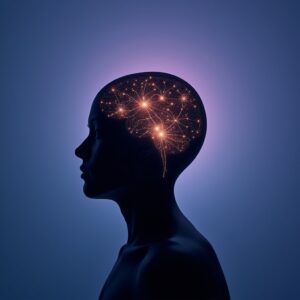Still Waters and Silent Witness : Meditation and the Three-Fold Mind
Understanding Meditation Through the Subconscious, Self-Conscious, and Superconscious Mind
by Brian S | July 23, 2025
Meditation is a topic with no shortage of wise voices and ancient systems. I’m not trying to propose some new ground breaking system, just to offer a perspective that’s helped me, and maybe it will help you, too. This is not an expert lecture, but a shared reflection.
 Let’s start with the three-level model of the mind: subconscious, self-conscious, and superconscious. This is not a clinical framework, but a practical one.
Let’s start with the three-level model of the mind: subconscious, self-conscious, and superconscious. This is not a clinical framework, but a practical one.
The subconscious is the part of ourselves that functions automatically. It governs everything we don’t actively think about. It keeps our heart beating, releases hormones, digests food, and repairs tissues. When we walk, we don’t consciously think, “Now tense the sartorius, then release and engage the gastrocnemius.” We simply walk. Certainly, this is the result of years of practice, but even babies begin walking without consciously directing every muscle. Likewise, mothers don’t micromanage the growth of a fetus in the womb. How overwhelming would that be? Thankfully, the subconscious is profoundly intelligent and easily handles such things.
But the subconscious does more than manage bodily functions. It’s in charge of our moods, personalities, and behaviors. It stores inherited instincts and emotional patterns shaped by experience. A shadow out of the corner of your eye might trigger a startle reflex before you consciously realize it was just a garden hose, not a snake. A childhood wound may quietly influence your adult relationships. A single bad encounter with a certain kind of person may influence how we react to similar people, even if we consciously know it’s not necessary.
The subconscious operates through symbol and intention. It is highly amenable to suggestion but not to logical instructions. You can’t give it step-by-step instruction. You have to present it with an image or desired outcome, and it works out how to get there on its own.
The self-consciousness is the active, deliberate part of the mind. It allows us to direct our attention, make decisions, and override automatic behaviors. While breathing is usually subconscious, self-consciousness can take the reins to slow the breath or shift it to the abdomen. We decide when to speak, where to look, how to move, what to eat, and what to think about.
Its chief power is concentration. What we focus on repeatedly begins to shape the patterns of the subconscious. The self-conscious acts as a lens or spotlight, choosing where to shine awareness, and in doing so, it influences what the subconscious absorbs and repeats.
The superconscious is more elusive. It is the realm of inspiration, moral insight, symbolic revelation, and spiritual vision. This is where we may receive divine guidance or flashes of insight. It doesn’t speak in plain words, but through sudden clarity, archetypes, synchronicities, or a quiet inner knowing.
The more we cultivate the subconscious and self-conscious, the clearer the superconscious becomes. It isn’t something we control, but something we align with.
In many esoteric systems, mind is symbolically related to the classical element of Water. Water is shapeless yet takes on the shape of its container. It is reflective, fluid, and powerful. The subconscious is like a vast ocean of mind-stuff; maleable, easily stirred, and often stormy. Bruce Lee echoed ancient Taoist wisdom when he said, “Be like water.”
Water adapts to its container but retains its essence. So too with the mind. When Jesus walks on water in the storm, it can be interpreted as He remains above the chaos of mass consciousness.
 When Peter tries to join Him, sinks as soon as he doubts. The storm is not just weather. It’s the state of the collective mind.
When Peter tries to join Him, sinks as soon as he doubts. The storm is not just weather. It’s the state of the collective mind.
The self-conscious can be likened to a periscope on a submarine. You can look out and get a limited perspective. The subconscious is the mechanics of the vessel itself. Concentration is the steering mechanism. Focus long enough, and the submarine navigation system will calculate the coordinates.
The classical element Air represents the structures of thought: the symbols, language, mathematics, concepts. If Water is the ocean of feeling and imagination, Air is the clarity of form that rides its currents. If we walk into a room right after a contentious argument, we can sense the “vibe” and that’s Water. But when our minds fill with language and mental images, that’s Air organizing Water into form.
Meditation is not just to sitting in lotus position. We actually meditate 24/7, but we are unconscious and our attention bounces from one stimulus to another:
“The alarm’s going off. I wish I could sleep longer. Did I send that email? What’s this pain in my shoulder? That person is beautiful. This song is annoying.”
True meditation begins when we hold our attention deliberately.
I like to think of meditation in two general categories: unseeded and seeded. Unseeded meditation is the practice of concentration on Nothing. You simply sit, observe, and allow thoughts and sensations to pass without grabbing onto one. If your shoulder hurts, you notice it without spiraling into self-blame or fear. Eventually, the waters of the subconscious begin to still, the silt settles, and your reflection becomes clear.
Seeded meditation is the deliberate focus on an object, concept, or symbol. It’s like grabbing onto a piece of floating debris in a stormy sea. At first, it’s just something to hold onto, but over time, you begin to study it. You notice its structure, its material, eventually even its message.
Spiritual traditions have handed us countless flotation devices: the cross, the lotus, the Star of David, the yin-yang. In our tradition, the Tarot is a particularly useful source of imagery. Each card is filled with symbols designed to speak to both self-conscious and subconscious levels. It gives the subconscious something to build with, while the self-conscious focuses on the form.
The subconscious responds to this kind of concentrated symbolic work. A fun experiment, proposed by Robert Anton Wilson, illustrates this: Imagine and expect to find a coin, such as a quarter. Focus on it. Believe it will happen. Then notice when it does. Is it magic? Suggestion? Synchronicity? Perhaps all three.
Manifesting coins or parking spaces becomes boring after a while.  You’ll find what’s truly important is directing your attention toward inner virtue. Store up treasure not on earth, but in Heaven. The Superconscious offers more than material reward. Once you calm the waters of the mind, it will point toward meaning, peace, and alignment with your Higher Self, which is far more valuable and exciting than anything prone to rust, moth, or theft.
You’ll find what’s truly important is directing your attention toward inner virtue. Store up treasure not on earth, but in Heaven. The Superconscious offers more than material reward. Once you calm the waters of the mind, it will point toward meaning, peace, and alignment with your Higher Self, which is far more valuable and exciting than anything prone to rust, moth, or theft.
When we find ourselves tossed about in the tumult of everyday life, meditation helps us return to ourselves and maybe even to something beyond. It isn’t about escaping the world or mastering the mind, but about observing with clarity, feeling with honesty, and concentrating with purpose. And sometimes, in that stillness, the superconscious whispers.
If you listen, it may not speak in words. But you will know.
